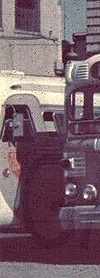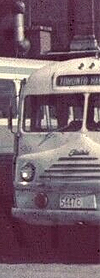| Rollsigns from Gray Coach Lines Toronto, Ontario |
| This linen destination sign was likely designed for a GMC parlour coach. It has no print date. It has 53 exposures. The sides at each end narrow from sign box wear, from years of in-service use. |

This linen route "via"
rollsign was likely
designed for a GMC
New Look. Like
Toronto's rollsigns,
they have an
identification letter
and a version
number. This one is
version
"I-13". It is dated
April 23, 1962, and
has 24 exposures.
Its sign tag is shown
below
rollsign was likely
designed for a GMC
New Look. Like
Toronto's rollsigns,
they have an
identification letter
and a version
number. This one is
version
"I-13". It is dated
April 23, 1962, and
has 24 exposures.
Its sign tag is shown
below

| This mylar set of signs are off Pederson Coach MCI MC-9 #478. This bus was formerly Gray Coach Lines #2247. The destination sign (left) is dated February 24, 1970, and has 57 exposures. The "Norfolk", "Washington", and Pittsburgh" exposures were added by Pederson Coach. The route "via" sign (right) is dated February 23, 1970 and (yes) has zero exposures. This is likely as a result of someone cropping out the GCL exposures and replacing only the blank stub. Their respective sign tags are shown below. |


M.C.I.GRAY COACH LINES
P.O. 17256-B
2/24/70 TRANSIGN CO.
P.O. 17256-B
2/24/70 TRANSIGN CO.
M.C.I. GRAY COACH LINES
P.O. P-17256-A
2/23/70 TRANSIGN
P.O. P-17256-A
2/23/70 TRANSIGN
6933525
G.M.DIESEL LTD.
P.O.A-84484-C 4/23/62
WATERPROOF WASHABLE
DESTINATION SIGNROLL
PRODUCT OF TRANSIGN
PONTIAC, MICHIGAN
G.M.DIESEL LTD.
P.O.A-84484-C 4/23/62
WATERPROOF WASHABLE
DESTINATION SIGNROLL
PRODUCT OF TRANSIGN
PONTIAC, MICHIGAN









Gray Coach Lines 1962 built GMDD
SDM 4501 (Serial #C009) suburban
New Look #1887, displaying a red "VIA"
rollsign similar to the one above the
photo, is seen in this undetermined
rural location (most likely westbound
on Lake Shore Road) in 1973.
(The photo from the collection of a
person that asked to remain anonymous,
but is used with permission.)
SDM 4501 (Serial #C009) suburban
New Look #1887, displaying a red "VIA"
rollsign similar to the one above the
photo, is seen in this undetermined
rural location (most likely westbound
on Lake Shore Road) in 1973.
(The photo from the collection of a
person that asked to remain anonymous,
but is used with permission.)
























This undated photo
shows a Gray Coach
Lines Fageol Twin
Coach bus with a
rollsign similar to the two
S.S.3 rollsigns seen
above-left. The buses
those two rollsigns came
from were similar to this.
(The photo from the
collection of a person
that asked to remain
anonymous, but is
used with permission.)
shows a Gray Coach
Lines Fageol Twin
Coach bus with a
rollsign similar to the two
S.S.3 rollsigns seen
above-left. The buses
those two rollsigns came
from were similar to this.
(The photo from the
collection of a person
that asked to remain
anonymous, but is
used with permission.)















| Gray Coach Lines was a suburban bus operator founded in 1927 by the Toronto Transportation Commission, the urban transit service provider in Toronto, Ontario. From 1927 to the 1930s, Gray Coach Lines acquired multiple competitors of all sizes in the Greater Toronto Area, and eventually dominated inter-urban bus service by the end of the 1930s. These acquisitions included Danforth Bus Lines and Hollinger Bus Lines of East York, Ontario, Roseland Bus Lines of Weston, Ontario, West York Coach Lines of York, Ontario, and Maple Leaf Coach Lines of Islington, Ontario. Gray Coach used inter-urban configured coaches to link Toronto to outlying areas throughout Ontario. Gray Coach also offered service to Buffalo, and in a pooling agreement with Greyhound, to New York City. In addition, Gray Coach operated sightseeing tour service in and around Toronto, eventually in association with Gray Line tours. Gray Coach Lines also provided one-hour Motor Launch Tours of the lagoons off Toronto's harbour and of the waterfront (used Amsterdam canal style boats with large glass top now run by Toronto Harbour Tours). The main bus terminal was at the Toronto Bus Terminal on Elizabeth Street at Bay Street in downtown Toronto. A secondary terminal for parcel service was operated on the northwest corner of Front Street and Sherbourne Street. Their garage facilities were located on Commissioners Street in Toronto's Harbour Headlands area. In addition to inter-urban bus service, Gray Coach Lines also operated several suburban and smaller express routes outside of the Toronto Transit Commission's urban network. These included: |
Beach — Operated from 1947 to 1952 between downtown and the Beaches via Eastern Avenue and Queen Street East.
Hill — The first city coach route started running in 1925, between Forest Hill and downtown via Forest Hill Road, Poplar Plains Road, Dupont Street, St. George Street, University Avenue,
Osgoode Street and Albert Streeet In 1931 it was extended north to Glenview Avenue (later Otter Loop). Service was withdrawn in September 1954 due to opening of the new Yonge subway.
Islington — In April 1929 Gray Coach Lines acquired Maple Leaf Coach Lines. MCL's Islington route (via Dundas Street from Runnymede Road to Bloor Street in the town of Islington, now
the area known as Six Points) was combined with the Lambton route and transferred to the TTC. It was transferred back to Gray Coach circa 1930. As of January 1, 1954 it was included
in the new Metropolitan Toronto operation, and Gray Coach buses were replaced by city buses.
Kingsway — Inaugurated in November 1945 between Bloor Street & Royal York Road and downtown via (South) Kingsway, Lake Shore Drive, Dowling Avenue and King Street, with an early
and late extension to Burnhamthorpe Road & Holloway Road via Bloor, Islington and Canning. Withdrawn in April 1946 after only five months of (presumably unsuccessful) operation.
Lambton — From Keele Street to Humber (Lambton Hotel) along Dundas Street Operated initially by the TTC for York Township, it was transferred to Gray Coach circa 1930.
As of January 1, 1954 it was included in the new Metropolitan Toronto operation, and Gray Coach buses were replaced by city buses.
Leaside — From May 1, 1953 to January 1, 1954 the Leaside bus was operated by Gray Coach Lines.
Rosedale — The Rosedale coach ran for just under two years (November 1928 to September 1930) between Summerhill Avenue & MacLennan Avenue and downtown via Glen Road,
Sherbourne Street, Isabella Street, Jarvis Street and Shuter Street to Yonge Street.
Woodbridge — Gray Coach acquired the Woodbridge route when the TTC bought out Roseland Bus Lines. From Lawrence and Weston via Weston Road, Albion Road, Thistletown,
Woodbridge Road, Highway 7, 8th Avenue and Pine Street (Woodbridge Avenue) to Pine Grove Road in Woodbridge, with Sunday trips operating through the Thistletown Hospital
(For Disturbed Children) grounds. The route was transferred to the TTC in December 1955 as Islington Bus (as 44 Islington 1956 to 1963 and now as 37 Islington).
Hill — The first city coach route started running in 1925, between Forest Hill and downtown via Forest Hill Road, Poplar Plains Road, Dupont Street, St. George Street, University Avenue,
Osgoode Street and Albert Streeet In 1931 it was extended north to Glenview Avenue (later Otter Loop). Service was withdrawn in September 1954 due to opening of the new Yonge subway.
Islington — In April 1929 Gray Coach Lines acquired Maple Leaf Coach Lines. MCL's Islington route (via Dundas Street from Runnymede Road to Bloor Street in the town of Islington, now
the area known as Six Points) was combined with the Lambton route and transferred to the TTC. It was transferred back to Gray Coach circa 1930. As of January 1, 1954 it was included
in the new Metropolitan Toronto operation, and Gray Coach buses were replaced by city buses.
Kingsway — Inaugurated in November 1945 between Bloor Street & Royal York Road and downtown via (South) Kingsway, Lake Shore Drive, Dowling Avenue and King Street, with an early
and late extension to Burnhamthorpe Road & Holloway Road via Bloor, Islington and Canning. Withdrawn in April 1946 after only five months of (presumably unsuccessful) operation.
Lambton — From Keele Street to Humber (Lambton Hotel) along Dundas Street Operated initially by the TTC for York Township, it was transferred to Gray Coach circa 1930.
As of January 1, 1954 it was included in the new Metropolitan Toronto operation, and Gray Coach buses were replaced by city buses.
Leaside — From May 1, 1953 to January 1, 1954 the Leaside bus was operated by Gray Coach Lines.
Rosedale — The Rosedale coach ran for just under two years (November 1928 to September 1930) between Summerhill Avenue & MacLennan Avenue and downtown via Glen Road,
Sherbourne Street, Isabella Street, Jarvis Street and Shuter Street to Yonge Street.
Woodbridge — Gray Coach acquired the Woodbridge route when the TTC bought out Roseland Bus Lines. From Lawrence and Weston via Weston Road, Albion Road, Thistletown,
Woodbridge Road, Highway 7, 8th Avenue and Pine Street (Woodbridge Avenue) to Pine Grove Road in Woodbridge, with Sunday trips operating through the Thistletown Hospital
(For Disturbed Children) grounds. The route was transferred to the TTC in December 1955 as Islington Bus (as 44 Islington 1956 to 1963 and now as 37 Islington).
| Gray Coach was contracted to operate some GO Transit bus services when the latter was started in 1971. Eventually GO Transit took over some of the shorter Gray Coach routes operating along the Hamilton-Toronto-Oshawa corridor and in the Greater Toronto Area. The contracting for GO Transit ended in 1985, when GO Transit began to completely operate as an independent entity. By the 1980s, Gray Coach faced fierce competition in the Greater Toronto Area. To strengthen its position, Gray Coach bid to acquire inter-urban operator Trentway-Wagar Ltd. However, facing budgetary pressure, the TTC decided to focus on its core urban transit service. In 1990 the TTC sold Gray Coach Lines to British carrier Stagecoach Holdings Ltd. Stagecoach then sold it to Greyhound Lines of Canada and Ontario Northland Motor Coach Services in 1993. Gray Coach's Gray Line franchised sightseeing operations were taken over by Greyhound Lines of Canada. After Gray Coach Lines dissolved, their garage facilities, still owned by the Toronto Transit Commission, were repurposed into the TTC's "Wheel-Trans" garage, their supplementary door-to-door service for the elderly and disabled. Similar to GO Transit, Gray Coach Lines' rollsign display is a two-piece configuration. The curb side sign (left) indicates the final destination of the bus. The street-side sign (right) shows the route taken to the destination. |
| This TTC marked version S.S.3 linen curb- side destination sign was removed from June 1948 built Fageol Twin Coach 41-S #1402. It is dated April 7, 1948 and has 53 exposures. he BEACH and HILL exposures were later additions to the sign, screened in house. The various sign tags are shown below. |
| This version S.S.3 linen curb-side destination sign was removed from June 1948 built Fageol Twin Coach 41-S #1400. It is dated April 7, 1948 and has 53 exposures. The BEACH and HILL exposures were later additions, but the HILL one came from a different narrower sign and needed widening strips on either side of the exposure. The various sign tags are shown below. |
| This TTC marked IS-4 linen curb-side destination sign was removed from 1948 built GMC PDA-3703 highway coach #1454. It has 46 exposures. This sign was screened in house at the TTC's facilities. On the sign it is written "NEW SIGN NOV. 15th/51" (1951). The TTC ID tag is shown below. |
| This TTC marked I-S-5 linen curb-side destination sign was removed from 1948 built GMC PDA-3703 highway coach #1462. It is dated April 7, 1949 and has 43 exposures. The various sign tags are shown below. |